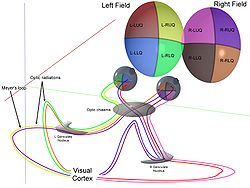- Optic radiation
-
Brain: Optic radiation 
Colour coded diagram showing radiations in quadrants from retinal disc through the brain Latin radiatio optica NeuroNames ancil-529 The optic radiation (also known as the geniculo-calcarine tract or as the geniculostriate pathway) is a collection of axons from relay neurons in the lateral geniculate nucleus of the thalamus carrying visual information to the visual cortex (also called striate cortex) along the calcarine fissure.
There is one such tract on each side of the brain.
Parts
A distinctive feature of the optic radiations is that they split into two parts on each side:
Source Path Information Damage Fibers from the inferior retina (also called "Meyer's loop" or "Archambault's loop") must pass through the temporal lobe by looping around the inferior horn of the lateral ventricle. Carry information from the superior part of the visual field A lesion in the temporal lobe that results in damage to Meyer's loop causes a characteristic loss of vision in a superior quadrant (quadrantanopia.) Fibers from the superior retina (also called "Baum's loop") travel straight back through the parietal lobe to the occipital lobe in the retrolenticular limb of the internal capsule to the visual cortex. Carry information from the inferior part of the visual field Taking the shorter path, these fibers are less susceptible to damage.  Right superior quadrantanopia. The areas of the visual field lost in each eye are shown as black areas. This visual field defect is characteristic of damage to Meyer's loop on the left side of the brain.
Right superior quadrantanopia. The areas of the visual field lost in each eye are shown as black areas. This visual field defect is characteristic of damage to Meyer's loop on the left side of the brain.
Additional images
External links
- Optic+radiation at eMedicine Dictionary
- Kier LE, Staib LH, Davis, LM, Bronen, RA (1 May 2004). "MR Imaging of the Temporal Stem: Anatomic Dissection Tractography of the Uncinate Fasciculus, Inferior Occipitofrontal Fasciculus, and Meyer’s Loop of the Optic Radiation". Am J Neuroradiology 25 (5): 677–691. PMID 15140705. http://www.ajnr.org/cgi/content/abstract/25/5/677. Retrieved 2007-12-19.
- http://www2.umdnj.edu/~neuro/studyaid/Practical2000/Q34.htm
Sensory system: Visual system and eye movement pathways Visual perception 1° (Bipolar cell of Retina) → 2° (Ganglionic cell) → 3° (Optic nerve → Optic chiasm → Optic tract → LGN of Thalamus) → 4° (Optic radiation → Cuneus and Lingual gyrus of Visual cortex → Blobs → Globs)Muscles of orbit TrackingHorizontal gazeVertical gazePupillary reflex Pupillary dilation1° (Posterior hypothalamus → Ciliospinal center) → 2° (Superior cervical ganglion) → 3° (Sympathetic root of ciliary ganglion → Nasociliary nerve → Long ciliary nerves → Iris dilator muscle)1° (Retina → Optic nerve → Optic chiasm → Optic tract → Visual cortex → Brodmann area 19 → Pretectal area) → 2° (Edinger-Westphal nucleus) → 3° (Short ciliary nerves → Ciliary ganglion → Ciliary muscle)Circadian rhythm M: EYE
anat(g/a/p)/phys/devp/prot
noco/cong/tumr, epon
proc, drug(S1A/1E/1F/1L)
Human brain, cerebrum, Interior of the cerebral hemispheres—Rostral Basal ganglia and associated structures (TA A14.1.09.321–552, GA 9.832–837) Basal ganglia Ventral striatumOtherInternal capsule (Anterior limb · Genu · Posterior limb, Optic radiation)
Corona radiata · External capsule · Extreme capsule
Pallidothalamic tracts: Thalamic fasciculus (Ansa lenticularis, Lenticular fasciculus) · Subthalamic fasciculusRhinencephalon Other basal forebrain Diagonal band of Broca · Stria terminalisArchicortex:
Hippocampal formation/
Hippocampus anatomyCategories:- Visual system
- Central nervous system
- Neuroscience stubs
Wikimedia Foundation. 2010.


